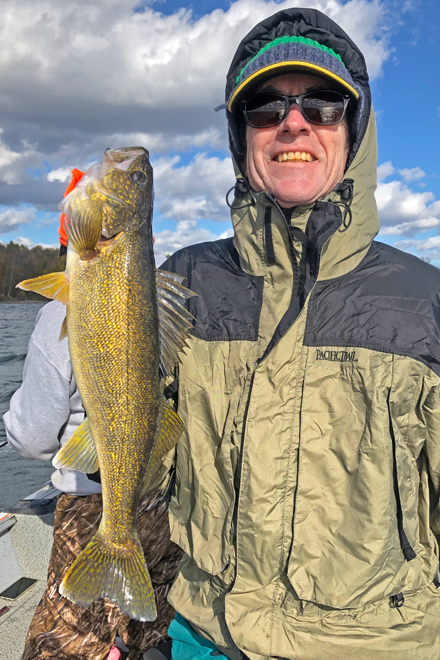Fall colors on Cutfoot Sioux have peaked, water temperatures have fallen and the end of the 2020 open water fishing season is visible on the horizon.
Fast Boats and Fall Colors on Cutfoot Sioux
Walleyes have turned the corner into the last phase of the open water fishing season. Responding to colder water temperatures, 52 to 53 degrees on the surface, feeding periods have become shorter, less intense, and are more dependent on the current climate.
When the wind blows, walleyes are active, they will move into shallow water to feed. Key depths have been 6 to 10 feet, depending on the structure. Fish move the shallowest wherever the current over windblown rocks offer feeding opportunities. Shoreline areas that do not feature rocky structure can produce fish too, but they will generally run a little deeper. Focus on 8 to 10 foot depths and concentrate on steeper drop-offs and inside corners.
Tim Higgins with Solid 22 Inch Winnie Walleye
Under calm, sunny conditions, we’ve experienced significantly slower action. Walleye become difficult to pin down as they move away from the shoreline and scatter across the flats. Some can still be caught by focusing on isolated gravel patches and rocky structure in water depths of 12 to 16 feet. Others can be caught by fishing along the breaklines that run into deep water. On Saturday, anglers who focused on water depths of 22 to 26 feet found fish that were willing to strike.
Cold water slows fish metabolism, so they feed less frequently, but usually, they still do feed. Spurts of sunset sunrise feeding behavior are common during these final weeks of the open water season. On days without a breeze, anglers who have done the best are those who concentrate on fishing during the predictable feeding periods that occur during low-light.
Jig and minnow presentations are the most common during fall. 1/8-ounce jigs tipped with minnows probably accounts for 90% of the fish being caught. There are folks catching them on alternative presentations too, so don’t be afraid to experiment. Lindy Rigs and live minnows are producing fish; use #1 or #2 minnow hooks and trim the leaders to about 6 feet long. Tip them with larger minnows, 5 to 7 inch Redtails, creek chubs or golden shiners will all produce fish.
Jigging raps and glow streaks have accounted for some fish this week and after dark, trolling shallow running crankbaits have produced fish as well.
No matter how we catch them, evidence abounds that walleyes are in full-scale fall migration mode. Fish of every shape and size are mixed together and the average size of fish in angler creels has greatly improved. Fish in the 14 to 15 inch range are most common, but there’s a healthy smattering of 16 to 17 fish coming in right now as well. The odds of catching large fish have gone way up too. Anglers frequently report catching 10 or more fish in the 20 to 24 inch size range on every outing.
Perch are more scattered these days, but when found, have been of quality size.
The spots that have produced best are slow tapering points in the 10 to 12 foot depth range. Most often, they are caught by anglers in pursuit of walleyes, especially on the big lake. In Cutfoot, gravel patches located along the outer edges of weed patches will produce good catches of perch, especially on cloudy, breezy days.
Jig and minnow presentations are most popular, but short leader Lindy Rigs are good too. Use #4 or #2 hook sizes, trim the leaders to about 2 feet long and tip them with larger fatheads. Troll or drift until you locate them, but then slow down and fish more deliberately, perch will respond well to vertical jigging, so stay close to the schools whenever you find them.
Panfish anglers have tried their best, but for most, crappie and bluegill action has been a disappointment. There are some small, scattered schools of panfish in both Cutfoot and Little Cutfoot, but it’s clear that populations are at low ebb right now. Some anglers do find them and have reported good catches, but the fish appear to be nomadic, rarely staying in the same spot for more than a day.
Tulibees, a fall spawning species, show up after dark on shallow flats that feature gravel or rock, their preferred spawning habitat for. Northern pike, muskies and larger bass move toward those shallow water flats and will lurk in cabbage, bulrush and other patches of green vegetation.
Casting large spinnerbaits into the green cabbage is an excellent way to catch some of the large predators. Jerk baits and large soft-plastic swim baits will also produce fish in these areas. During Late fall, the whole trick is to find the right combination of habitats, after that; there’s no temperature too cold for the fish. This pattern will last from now, into the deer hunting season.
Around the resort, the fishing action is winding down for the season. At the marina, we have the docks pulled out of the water. Our remaining guests are focused more on grouse hunting than on fishing, but we’ll be keeping tabs on some of our friends who still have fishing trips planned for themselves. We’ll keep you posted about major changes to fishing patterns, if and when they occur.



